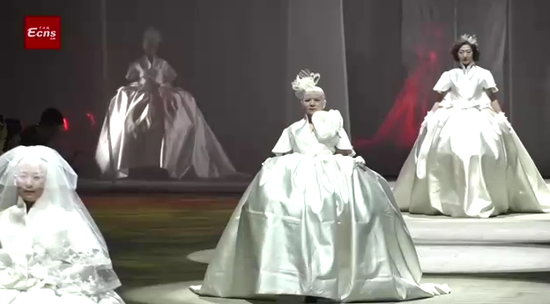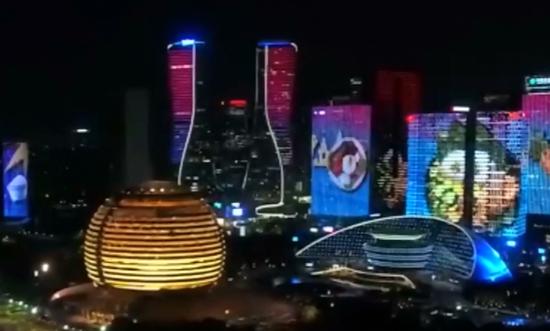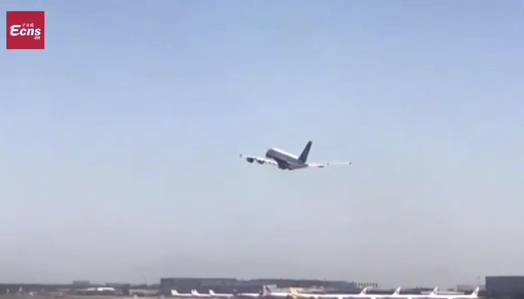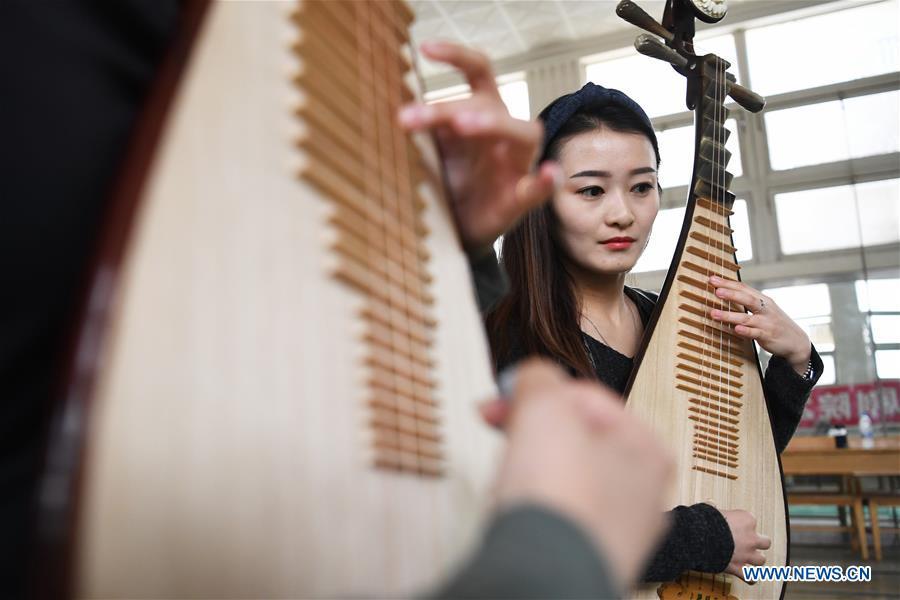
Player Zhao Xiaotong practices playing the pipa at Lanzhou traditional orchestra in Lanzhou, northwest China's Gansu Province, May 13, 2019. Pipa, a pear-shaped stringed instrument, is one of the traditional Chinese musical instruments. The pipa is played vertically and can be found in solos, ensembles or orchestras. The images of flying apsaras playing the pipa have been seen on murals in Gansu's Dunhuang Mogao Grottoes, a 1,600-year-old UNESCO world heritage site located at a cultural and religious crossroads area on the ancient Silk Road in Gansu. Nowadays contemporary dance performances inspired from those images on the murals have been staged times and times again. (Xinhua/Chen Bin)
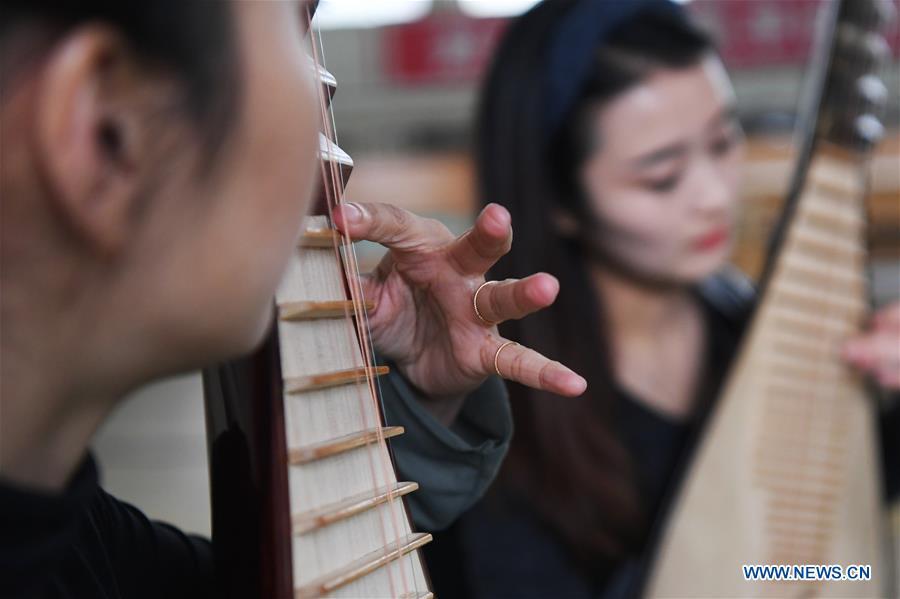
Players Zhang Geping (L) and Zhao Xiaotong practice playing the pipa at Lanzhou traditional orchestra in Lanzhou, northwest China's Gansu Province, May 13, 2019. Pipa, a pear-shaped stringed instrument, is one of the traditional Chinese musical instruments. The pipa is played vertically and can be found in solos, ensembles or orchestras. The images of flying apsaras playing the pipa have been seen on murals in Gansu's Dunhuang Mogao Grottoes, a 1,600-year-old UNESCO world heritage site located at a cultural and religious crossroads area on the ancient Silk Road in Gansu. Nowadays contemporary dance performances inspired from those images on the murals have been staged times and times again. (Xinhua/Chen Bin)
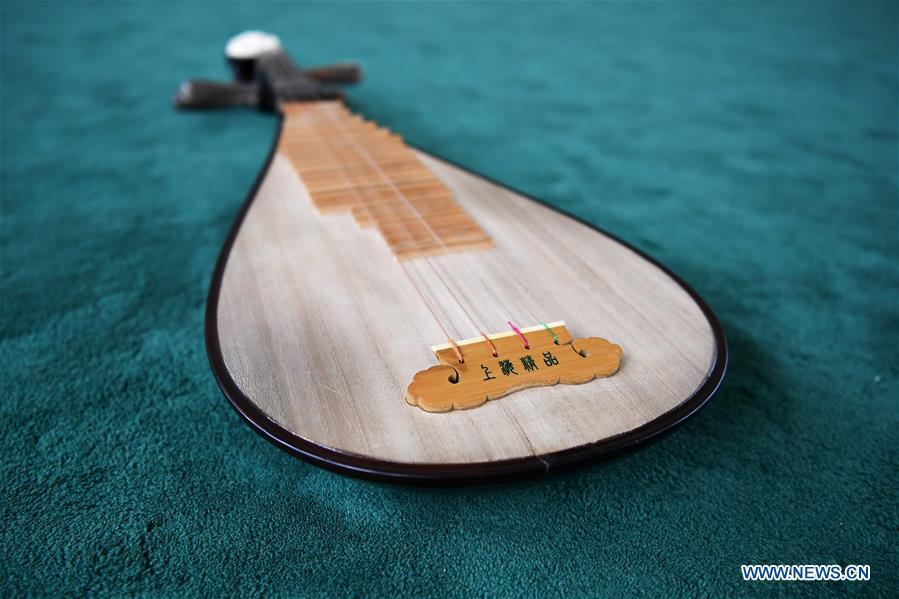
Pipa is pictured at Lanzhou traditional orchestra in Lanzhou, northwest China's Gansu Province, May 13, 2019. Pipa, a pear-shaped stringed instrument, is one of the traditional Chinese musical instruments. The pipa is played vertically and can be found in solos, ensembles or orchestras. The images of flying apsaras playing the pipa have been seen on murals in Gansu's Dunhuang Mogao Grottoes, a 1,600-year-old UNESCO world heritage site located at a cultural and religious crossroads area on the ancient Silk Road in Gansu. Nowadays contemporary dance performances inspired from those images on the murals have been staged times and times again. (Xinhua/Chen Bin)
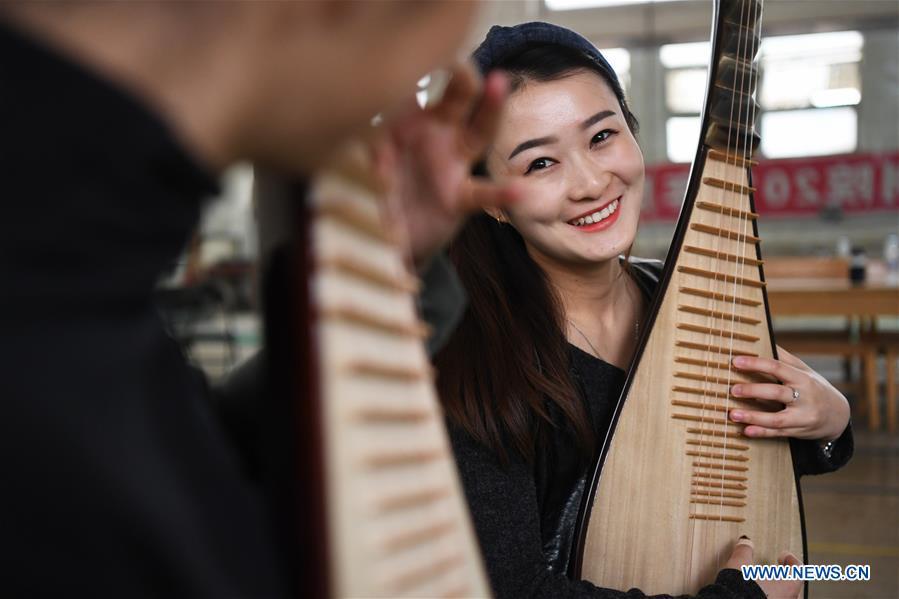
Player Zhao Xiaotong practices playing the pipa at Lanzhou traditional orchestra in Lanzhou, northwest China's Gansu Province, May 13, 2019. Pipa, a pear-shaped stringed instrument, is one of the traditional Chinese musical instruments. The pipa is played vertically and can be found in solos, ensembles or orchestras. The images of flying apsaras playing the pipa have been seen on murals in Gansu's Dunhuang Mogao Grottoes, a 1,600-year-old UNESCO world heritage site located at a cultural and religious crossroads area on the ancient Silk Road in Gansu. Nowadays contemporary dance performances inspired from those images on the murals have been staged times and times again. (Xinhua/Chen Bin)
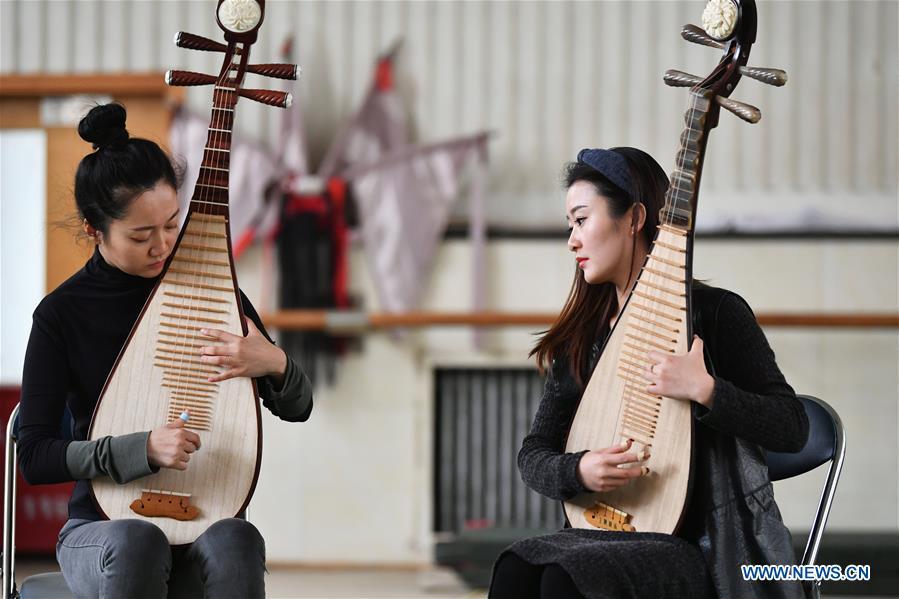
Players Zhang Geping (L) and Zhao Xiaotong practice playing the pipa at Lanzhou traditional orchestra in Lanzhou, northwest China's Gansu Province, May 13, 2019. Pipa, a pear-shaped stringed instrument, is one of the traditional Chinese musical instruments. The pipa is played vertically and can be found in solos, ensembles or orchestras. The images of flying apsaras playing the pipa have been seen on murals in Gansu's Dunhuang Mogao Grottoes, a 1,600-year-old UNESCO world heritage site located at a cultural and religious crossroads area on the ancient Silk Road in Gansu. Nowadays contemporary dance performances inspired from those images on the murals have been staged times and times again. (Xinhua/Chen Bin)
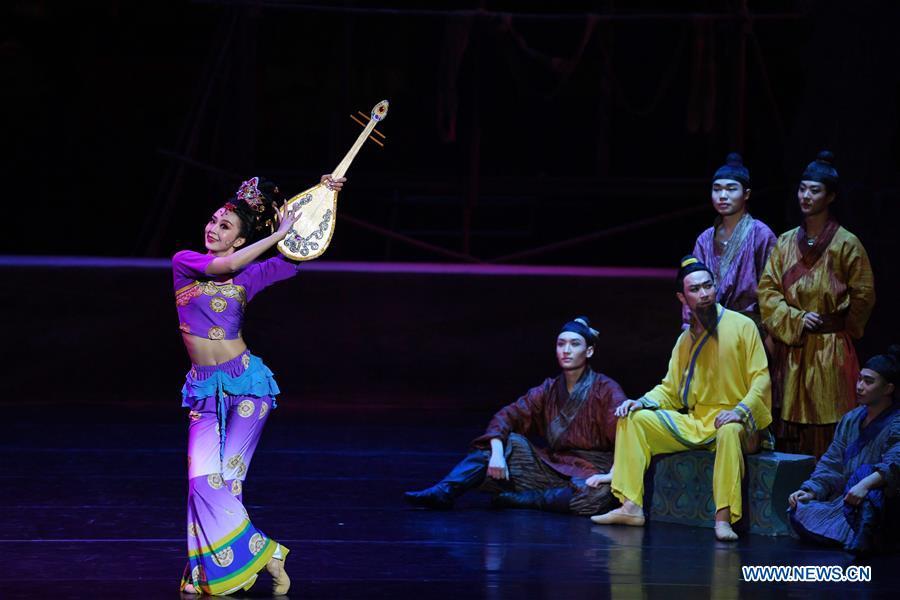
A performer holding the stage property of pipa dances during the Chinese classic dance drama "Flower Rains along Silk Road" at Dunhuang Grand Theatre in Dunhuang, northwest China's Gansu Province, April 2, 2019. Pipa, a pear-shaped stringed instrument, is one of the traditional Chinese musical instruments. The pipa is played vertically and can be found in solos, ensembles or orchestras. The images of flying apsaras playing the pipa have been seen on murals in Gansu's Dunhuang Mogao Grottoes, a 1,600-year-old UNESCO world heritage site located at a cultural and religious crossroads area on the ancient Silk Road in Gansu. Nowadays contemporary dance performances inspired from those images on the murals have been staged times and times again. (Xinhua/Chen Bin)
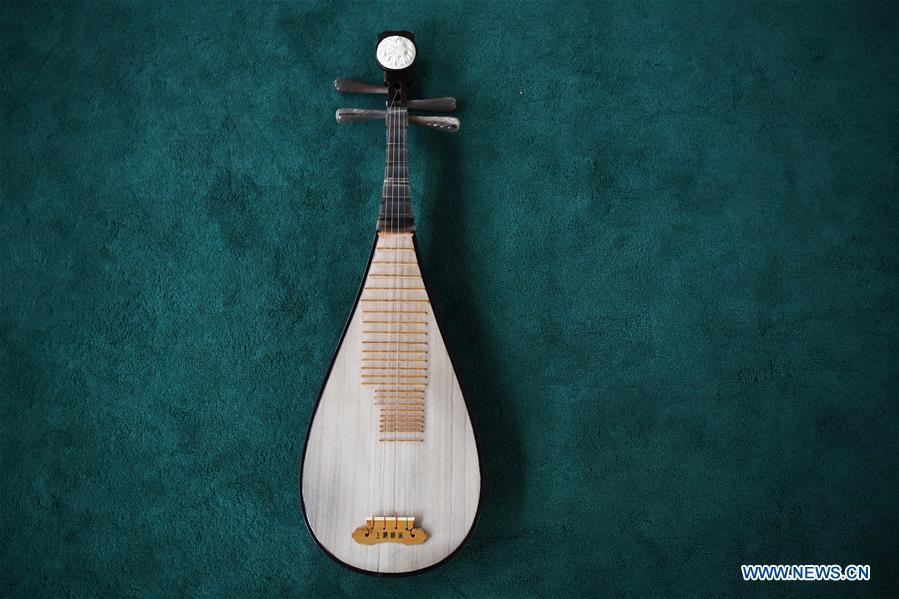
Pipa is pictured at Lanzhou traditional orchestra in Lanzhou, northwest China's Gansu Province, May 13, 2019. Pipa, a pear-shaped stringed instrument, is one of the traditional Chinese musical instruments. The pipa is played vertically and can be found in solos, ensembles or orchestras. The images of flying apsaras playing the pipa have been seen on murals in Gansu's Dunhuang Mogao Grottoes, a 1,600-year-old UNESCO world heritage site located at a cultural and religious crossroads area on the ancient Silk Road in Gansu. Nowadays contemporary dance performances inspired from those images on the murals have been staged times and times again. (Xinhua/Chen Bin)
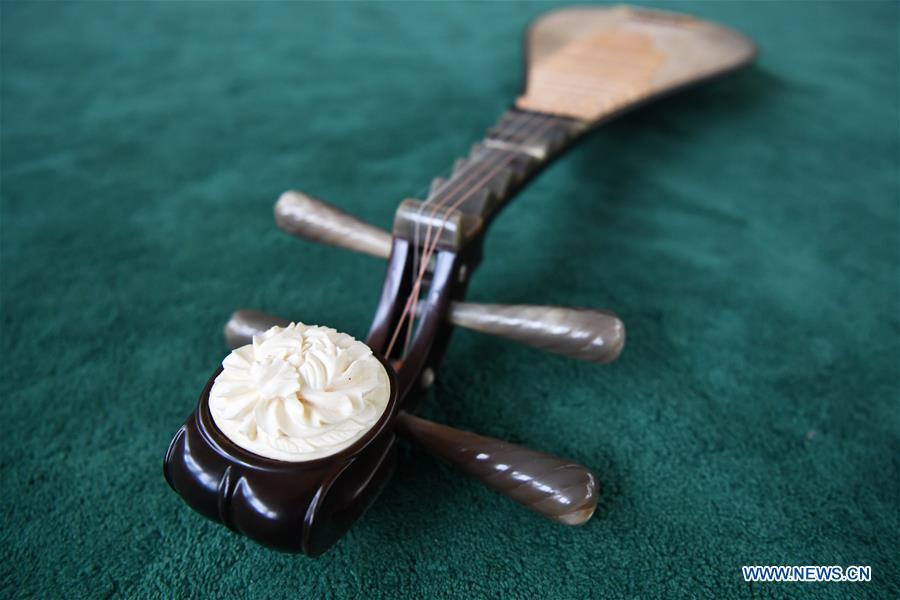
Pipa is pictured at Lanzhou traditional orchestra in Lanzhou, northwest China's Gansu Province, May 13, 2019. Pipa, a pear-shaped stringed instrument, is one of the traditional Chinese musical instruments. The pipa is played vertically and can be found in solos, ensembles or orchestras. The images of flying apsaras playing the pipa have been seen on murals in Gansu's Dunhuang Mogao Grottoes, a 1,600-year-old UNESCO world heritage site located at a cultural and religious crossroads area on the ancient Silk Road in Gansu. Nowadays contemporary dance performances inspired from those images on the murals have been staged times and times again. (Xinhua/Chen Bin)







